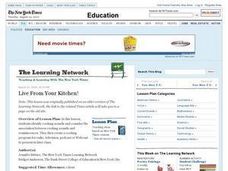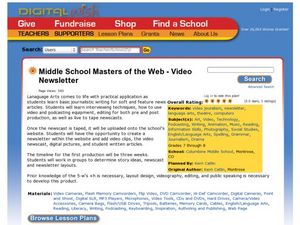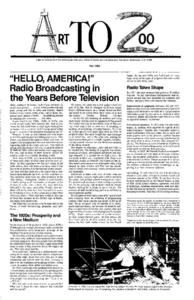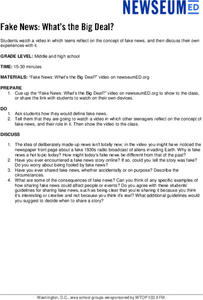Facing History and Ourselves
#IfTheyGunnedMeDown
As part of their continued investigation of the reporting of the shooting of Michael Brown class members analyze photos of Michael Brown and the social media response to these images. The class then develops a guide they...
Facing History and Ourselves
The Importance of a Free Press
"Congress shall make no law . . . abridging the freedom of speech, or of the press;. . ." Why is this guarantee of free speech and a free press the First Amendment to the US Constitution? Why are these rights so essential to a...
Facing History and Ourselves
The Power of Images
One picture but a thousand stories. As a part of a case study of how the death of Michael Brown was reported by professional news sources and on social media class members examine the reactions of various groups to a photograph taken by...
Facing History and Ourselves
Verifying Breaking News
The attempts of journalists to verify the events surrounding the shooting of Michael Brown take center stage as individuals analyze three of the initial newspaper accounts of the story. The whole class discussion then focuses...
Curated OER
President FDR and the New Deal
Students explore the New Deal and President FDR. In this Great Depression lesson plan, students listen to an FDR Broadcast (Fireside Chat) and read sections in their textbooks. Then, in small groups students design and create a broadcast...
Curated OER
World War II
Sixth graders read Under the Blood Red Sun (UBRS), V is for Victory (V), and Number the Stars(NS). They examine WWII through the eyes of Japanese, Danish, and American students and complete at least two projects: a radio broadcast and a...
Curated OER
Live From Your Kitchen!
Learners identify cooking sounds and share opinions about their associations. After reading an article, they discover the growth of radio cooking shows. They prepare an outline and script for a cooking program and present their...
Curated OER
How Media Shapes Perception
Young scholars explain the impact that the media may have in shaping their intellectual and emotional responses to current events. They examine broadcast and Web-based news sites to find subtexts through the use of language, audio, and...
Curated OER
Media Arts: Creating Great Audio for Video
Students learn the basic concepts necessary to produce broadcast quality audio recordings of human speech, which can then be used in professional radio or television productions.
Curated OER
Shaping the News
Students explore television journalism. In this journalism lesson, students discuss the attributes of television broadcasting. Students then review their journalism code of ethics and then conduct research for stories that have a moral...
Curated OER
The Power of One: Convergence in Scholastic Media
Pupils explore the different forms of media utilized by journalism including writing, photography, video, sound and the Internet. In this journalism lesson, students compare and contrast the ways in which information is presented between...
Curated OER
Weather Report
Students prepare a weather script for a broadcast. For this weather broadcasting lesson, student record the present temperature, high temperature, a sky watch, and the current moon phase to be presented in a school broadcast at the...
Curated OER
The Electric Experience
Students investigate the effects of television and radio on culture. In this journalism lesson, students consider how electronic media has shaped journalism as they create timelines that feature the changes and compare and contrast print...
Curated OER
Power and Impact of Radio as a Broadcast Medium
Students compare radio coverage of news events with coverage of 21st century new stories. They analyze various forms of media as they relate to news coverage. They write an essay comparing the impact of radio versus that of television
Social Media Toolbox
Reporting with Social Media
What does it take to create news stories that are both informative and objective? Aspiring journalists walk the line between engagement and activism with activity 15 of a 16-part series titled The Social Media Toolbox. Grouped pupils...
Media Smarts
Bias
See how bias operates firsthand. Half of the class reads one article while the other half reads another article on the same event. The obvious differences emerge when the two sides talk about their observations though. Several handouts...
Curated OER
Middle School Masters of the Web- Video Newsletter
Students develop a school newscast. In this school newscast lesson, students practice interviewing skills, use of video and podcasting equipment, and editing skills. They work in groups to develop a school newscast using digital pictures...
Curated OER
The World in 22 Minutes: Constructing a TV News Lineup
Students examine several newspapers to compare front pages, headlines, and photographs, experience role of news editor, define and discuss factors that go into news judgements, and arrange twenty-two minute news broadcast by selecting...
Curated OER
Student Leadership Activity
Students rotate in groups of three to broadcast the morning news/announcements over the school pa system. They meet with the principal once a month to find volunteer opportunities. They also are responsible for organizing sports teams...
Curated OER
Radio Broadcasting Before Television
Students compare the radio to other forms of mass communication. In this Radio Broadcasting Before Television lesson, students learn the different types of radio shows in the 1920s and 30s. Students write and perform radio scripts...
Curated OER
Radio News
Part of a larger unit from the Media Awareness Network on media literacy, this particular lesson plan focuses on the medium of news radio. Small groups participate in discussions on their radio listening habits as well as the...
Curated OER
World War II Multimedia Newscast: History, Technology, Journalism
Learners compose a multi-media newscast on various subjects relating to WWII to demonstrate their knowledge and ability to research.
Newseum
Media Ethics: Fairness Formula Starts With Accuracy
As part of a study of media ethics, young journalists apply a fairness formula to news reports. They look at accuracy, balance, completeness, detachment, and ethics to determine if the reporting is fair.
Newseum
Fake News — What's the Big Deal?
In a time of fake news and alternative facts, young people must have the ability to identify it and its role. Scholars watch a video of teens reflecting on the concept of fake news and the impact of sharing fake news stories. They then...
Other popular searches
- Radio Broadcast
- Broadcast Advances
- Broadcast News
- Broadcast Media
- Teach Broadcast Journalism
- Broadcast Journalism Ethics
- Broadcast Journalism Writing
- 1920s Radio Broadcast
- Broadcast Journalism in War
- Radio Broadcast Script
- Broadcast Journalism Video
- Broadcast Video Production























